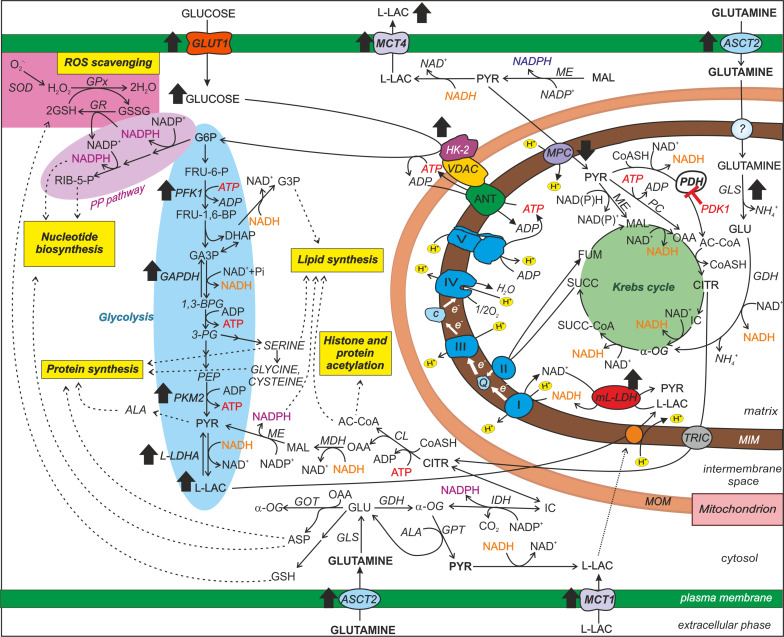Scheme 1.
Primary metabolic changes occurring in cancer cells. Glycolysis, the oxidative phase of the pentose phosphate pathway, OXPHOS, the Krebs cycle and glutamine and l-lactate metabolism are schematically represented to emphasize their contributions to biomass synthesis, ROS scavenging and histone/protein acetylation. The black-filled arrows indicate the increase/decrease in the activity/expression of key enzymes and metabolites occurring in most cancers and playing a critical role in cancer cell metabolism (for details and references see the text). Glucose and glutamine are shown as the major carbon sources in proliferating cells. l-LAC is shown to enter mitochondria in a carrier-mediated manner and become oxidized by the ml-LDH. These processes lead to energy production via OXPHOS and PYR formation in the matrix (a more detailed representation is given in Scheme 2). The preferential access of HK-2 to mitochondrial ATP and its linkage to VDAC are also schematically represented. Abbreviations not included in the text: e− electrons; carriers: ASCT2 alanine, serine, cysteine-preferring transporter 2, TRIC tricarboxylate carrier, ? unknown mitochondrial glutamine carrier. Enzymes: CL citrate lyase, GAPDH glyceraldehyde-3-phosphate dehydrogenase, GDH glutamate dehydrogenase, GLS glutamine synthase, GR glutathione reductase, MDH malate dehydrogenase, ME malic enzyme, PC pyruvate carboxylase. Metabolites: AC-CoA acetyl coenzyme A, ASP aspartate, CITR citrate, CoASH coenzyme A, FUM fumarate, FRU-6-P fructose-6-phosphate, FRU-1,6-BP fructose-1,6-bisphosphate, GLU glutamate, IC isocitrate, α-OG α-oxoglutarate, MAL malate, PEP phosphoenolpyruvate, 3-PG 3-phosphoglycerate, 1,3-BPG 1,3-bisphosphoglycerate, RIB-5-P ribose-5-phosphate, SUCC succinate, SUCC-CoA succinyl-CoA. Respiratory chain complexes: I NADH dehydrogenase, II succinate dehydrogenase, Q coenzyme Q, III complex III, c cytochrome c, IV cytochrome c oxidase, V ATP synthase

